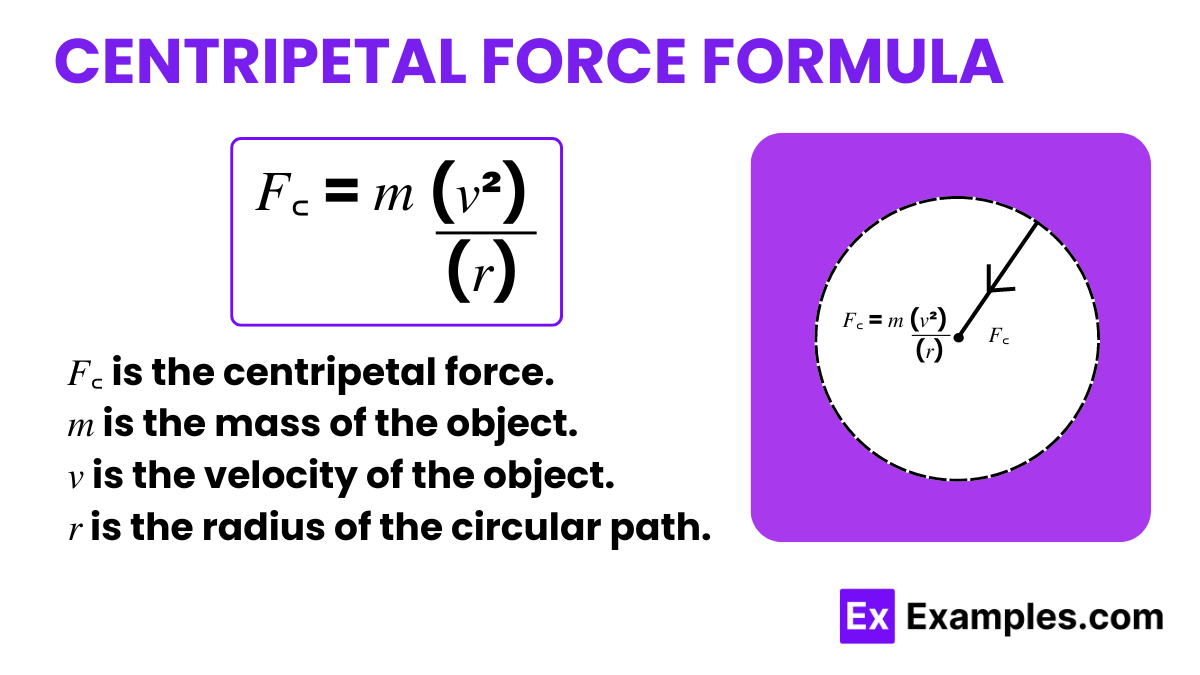What is the formula for centripetal force?
F꜀ = mv²/r
F꜀ = m/v²r
F꜀ = mr/v²
F꜀ =mv²r/2


The centripetal force formula is a key equation in physics that quantifies the force required to maintain an object’s motion along a circular path. This formula is crucial for understanding and predicting the behaviors of objects in circular motion, ranging from electrons in magnetic fields to cars turning on curved roads. It specifically calculates the necessary inward force that keeps an object moving in a circle at a constant speed, without spiraling outwards or inwards.
Sir Isaac Newton first derived this formula based on his laws of motion, particularly the second law, which relates force to mass and acceleration. In the case of circular motion, the relevant acceleration is centripetal acceleration, which always points toward the center of the circle. The centripetal force formula is mathematically expressed as
This formula indicates that the centripetal force depends directly on the mass of the object and the square of its velocity, and inversely on the radius of the path. Such a relationship is pivotal for ensuring stability in systems undergoing rotational motion, allowing for precise calculations in engineering and physics applications. By applying Newton’s second law,
and recognizing that the acceleration a in circular motion is given by
we derive the specific formula for the force keeping an object in circular motion. This highlights the seamless integration of Newtonian mechanics into understanding and solving practical problems in real-world physics scenarios.
A car with a mass of 1500 kg is traveling around a curve with a radius of 50 meters at a speed of 20 meters per second. Calculate the centripetal force exerted on the car to maintain its circular path.
Solution: Using the centripetal force formula 𝐹꜀=𝑚 x (𝑣² / 𝑟)
𝐹꜀=1500 (20² / 50) =1500 (400 / 50) = 1500×8 = 12,000 N
Thus, the centripetal force required is 12,000 Newtons.
A 5 kg object is tied to a string and swung in a horizontal circle with a radius of 2 meters. If the tension in the string providing the centripetal force is 98 Newtons, what is the speed of the object?
Solution: Rearrange the centripetal force formula to solve for velocity v: 𝐹𝑐=𝑚 x (𝑣² / 𝑟)
98=5 (𝑣² / 2)
v² / 2 =98 / 5
v² = (98 / 5) × 2 =39.2
𝑣 = √39.2 ≈ 6.26 m/s The object’s speed is approximately 6.26 meters per second.
During the spin cycle, a washing machine spins clothes at a rate of 800 revolutions per minute (rpm) in a drum of radius 0.3 meters. Calculate the centripetal force acting on a 0.5 kg wet shirt.
Solution: First, convert rpm to radians per second:
Angular velocity (𝜔)=800 × (2𝜋 / 60) ≈ 83.78 rad/s
The linear velocity 𝑣v is given by 𝑣=𝑟𝜔:
𝑣=0.3×83.78≈25.13 m/s
Now, use the centripetal force formula: 𝐹𝑐 = 𝑚 (𝑣² / r)
𝐹𝑐 =0.5 (25.13² / 0.3)
𝐹𝑐=0.5 × (631.53 / 0.3) ≈1052.55 N.
The centripetal force on the shirt is approximately 1052.55 Newtons.
Centripetal force is calculated using the formula 𝐹𝑐 = 𝑚 (𝑣² / r). Where m is mass, v is velocity, and r is radius.
The formula for centripetal force is 𝐹𝑐 = 𝑚 (𝑣² / r) . For acceleration, it is a = (𝑣² / r).
Centripetal force formula: 𝐹𝑐 = 𝑚 (𝑣² / r). Centrifugal force, perceived in a rotating frame, mirrors this: 𝐹բ=𝑚 (𝑣² / r).
Text prompt
Add Tone
10 Examples of Public speaking
20 Examples of Gas lighting
What is the formula for centripetal force?
F꜀ = mv²/r
F꜀ = m/v²r
F꜀ = mr/v²
F꜀ =mv²r/2
What is the centripetal force acting on a 2 kg object moving at a speed of 4 m/s in a circle of radius 3 m?
8 N
10.67 N
32 N
16 N
If the speed of an object moving in a circular path is doubled, how does the centripetal force change?
It remains the same
It is doubled
It is quadrupled
It is halved
A car of mass 1000 kg takes a turn around a curve with a radius of 50 m at a speed of 20 m/s. What is the centripetal force acting on the car?
4000 N
8000 N
10,000 N
16,000 N
What happens to the centripetal force if the radius of the circular path is increased while keeping the speed and mass constant?
It increases
It decreases
It remains the same
It becomes zero
A 0.5 kg ball is whirled in a horizontal circle with a radius of 2 m at a speed of 3 m/s. What is the centripetal force?
1.5 N
3.0 N
2.25 N
4.5 N
An object moves in a circle of radius 4 m with a speed of 6 m/s. If the mass of the object is 2 kg, what is the centripetal force?
12 N
14 N
16 N
18 N
Which of the following factors does NOT affect the centripetal force required to keep an object moving in a circle?
Mass of the object
Speed of the object
Radius of the circle
Shape of the object
What is the centripetal force on a 0.2 kg object moving with a velocity of 5 m/s in a circle of radius 0.5 m?
10 N
20 N
25 N
50 N
What is the centripetal acceleration of an object moving at a speed of 4 m/s in a circle of radius 2 m?
4 m/s²
6 m/s²
8 m/s²
10 m/s²
Before you leave, take our quick quiz to enhance your learning!

